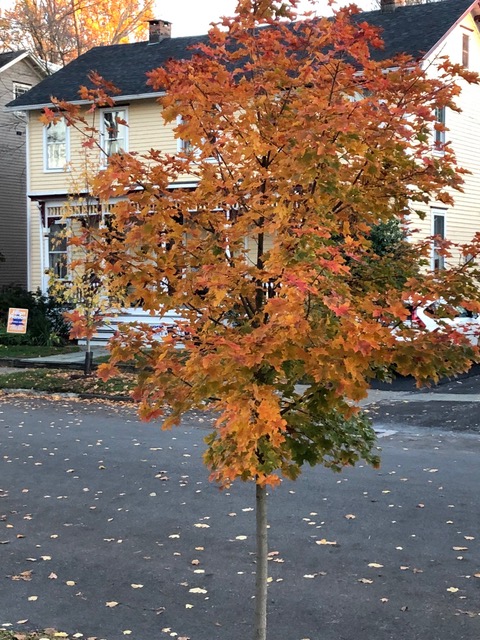Having left Rhinebeck for New York City in mid-September, I was unable to come back until early October. When I returned the house welcomed me as an old dog would have: “Hello. So glad you are back. It’s a beautiful sunny day. Come into the garden.”
The garden did not miss me. The pots of herbs outside the kitchen door were still there, robust but hardly used. I tend to forget about them even when I’m cooking, the very reason they were placed so close to the kitchen door. The Sungold tomatoes, finally bearing a small crop, were not worth the real estate they occupied. It is a dreary plant, not to be repeated next year.
Our shared garden continues to look better every year, although the milkweed planted to entice the Monarchs to settle in with us, disappeared early. One peony finally bloomed this spring after years of doing nothing. The lespedeza, always a dependable late blue, barely showed itself. It has been a stalwart of the shared garden from the beginning but is sulking this year.
I dipped my toe in the aster family this fall, starting with Aster x Frikarti ‘Monch’. It was a lovely blue and will be perfect next year paired with Brown-eyed Susan and Goldenrod. This year it was on its own; on trial as it were. Robin Lane Fox in the Financial Times (October 29-30, 2022, Got the Autumn Blues) covered several column inches with a round-up of suggestions for blues in the late summer garden, so I anticipate having more blues next year.
Cimicifuga is the star of my late summer garden. The correct name these days is Actaea, but in my heart it will always be Cimicifuga. There are two varieties – one with upright candelabra flowers, and a droopy one. The upright (my favorite as you may have guessed) stretches out so slowly that if you sit nearby, you can almost watch it grow. This year ‘sports’ have popped up around the garden – same foliage, different bud and flower shapes, different bloom times. An interesting puzzle.
By October, Anemone Honorine Jobert is in full bloom – luminous white flowers catching the last of the light, brilliant alongside Fothergilla coloring up for Fall. On the street, the Shantung Maples planted last year are earning their keep. They are still in full color, holding their leaves long after the other street trees have shed theirs. The Winged euonymus, buried in the back of the garden, is a vibrant red as is the Aronia along the driveway.
The lawn (a euphemism for Creeping Charlie and his cousins cut down as grass) is carpeted in yellow -- fallen leaves from the black walnuts first, then the maples. Leaf-raking doesn’t start here till all the leaves have fallen. Happily, what might appear messy to some is glorious to me. Delfino Martinez and his crew have taken over leaf-raking -- what would be the householder’s task if the householder was someone other than myself.
When the time approached to bring the potted tender plants indoor I balked; they had grown too large to winter-over in the house, and I turned the job over to Cheshire Nursery in Connecticut. A truck picked them up and drove them down to Connecticut. The nursery will store them over the winter and return them in the spring – I hope. One huge mandevilla, two sentimental plumbago, one tree fern, and one lemon tree.
Daylight Savings Time has ended and we are back to Standard. Holiday catalogs are arriving with the anticipated selection of potted amaryllis. If you are ambitious and have a space to store them, it is possible to coax amaryllis into a second flowering. After they have finished blooming remove the flower stalk and fertilize monthly with Miracle-Gro or equivalent. By mid-summer cut back on your watering schedule by one-half. Once the foliage has yellowed cut the leaves back to an inch above the bulb and store the pots in a dark, cool location for about six weeks. Then bring them into a sunny window and start all over again.
I should say that I don’t do any of this, but you might well want to. I buy one fresh amaryllis each year and devote the rest of the winter to paperwhite narcissus planted in pebbles. I always have a few bowls waiting in the wings, and one in a window with good light.
By the end of this month you should have completed putting the garden to bed for the winter, turned off and drained all outside water lines, coiled your hoses and brought them indoors. Make sure your garden equipment and tools are clean; you can oil them over the winter. When everything is cut down, put away, tidied up, mulched, wrapped and swept you can review your gardening year from a comfortable chair and plan for spring.








